2024年中考英语人教版一轮复习专题讲义 学案 第1讲 简单句
文档属性
| 名称 | 2024年中考英语人教版一轮复习专题讲义 学案 第1讲 简单句 | 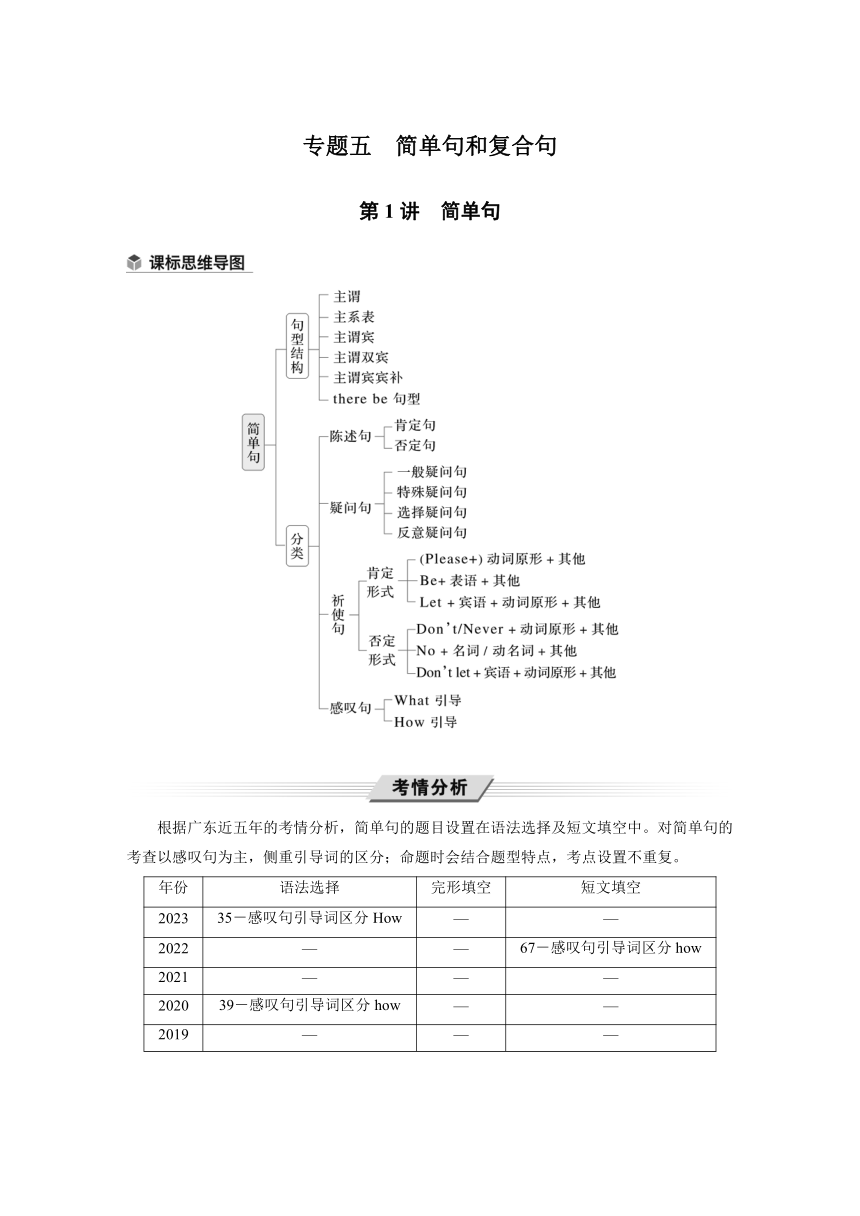 | |
| 格式 | docx | ||
| 文件大小 | 318.7KB | ||
| 资源类型 | 教案 | ||
| 版本资源 | 通用版 | ||
| 科目 | 英语 | ||
| 更新时间 | 2024-03-11 21:31:11 | ||
图片预览

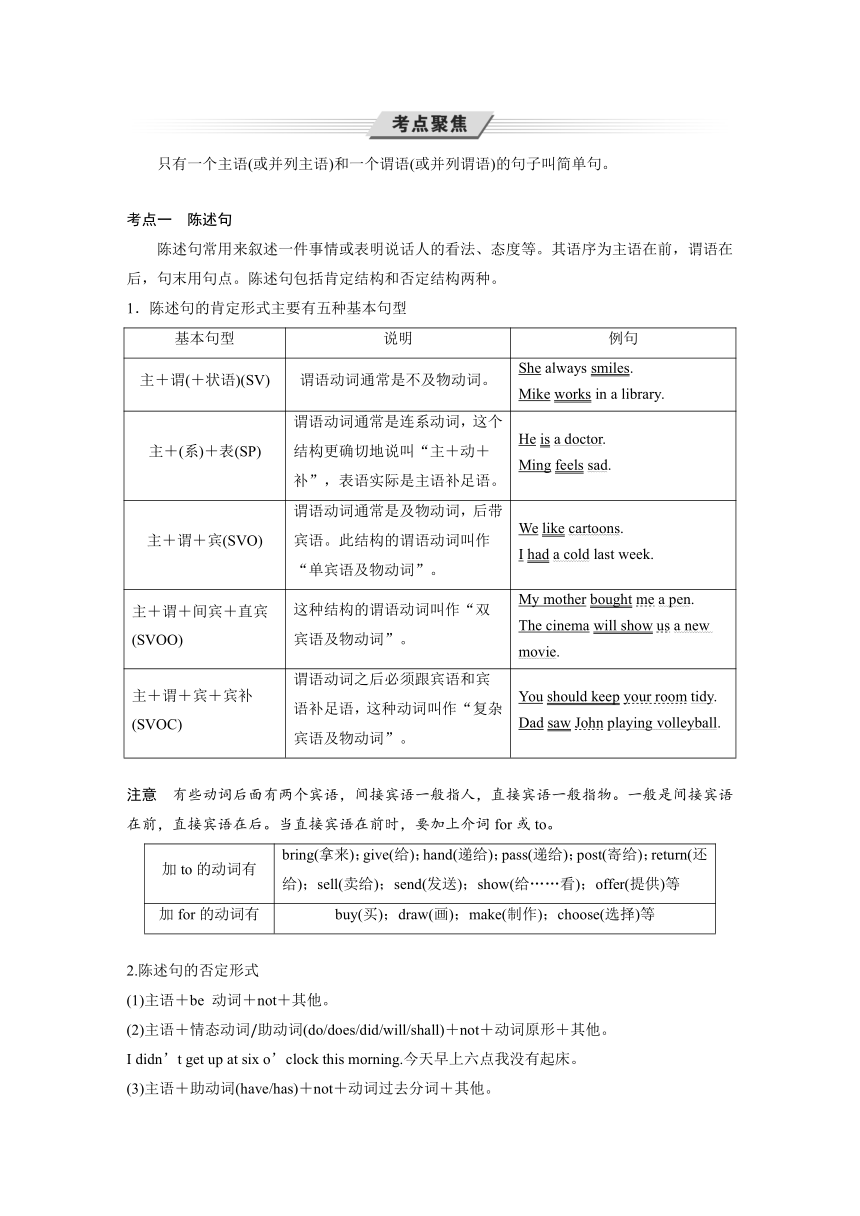
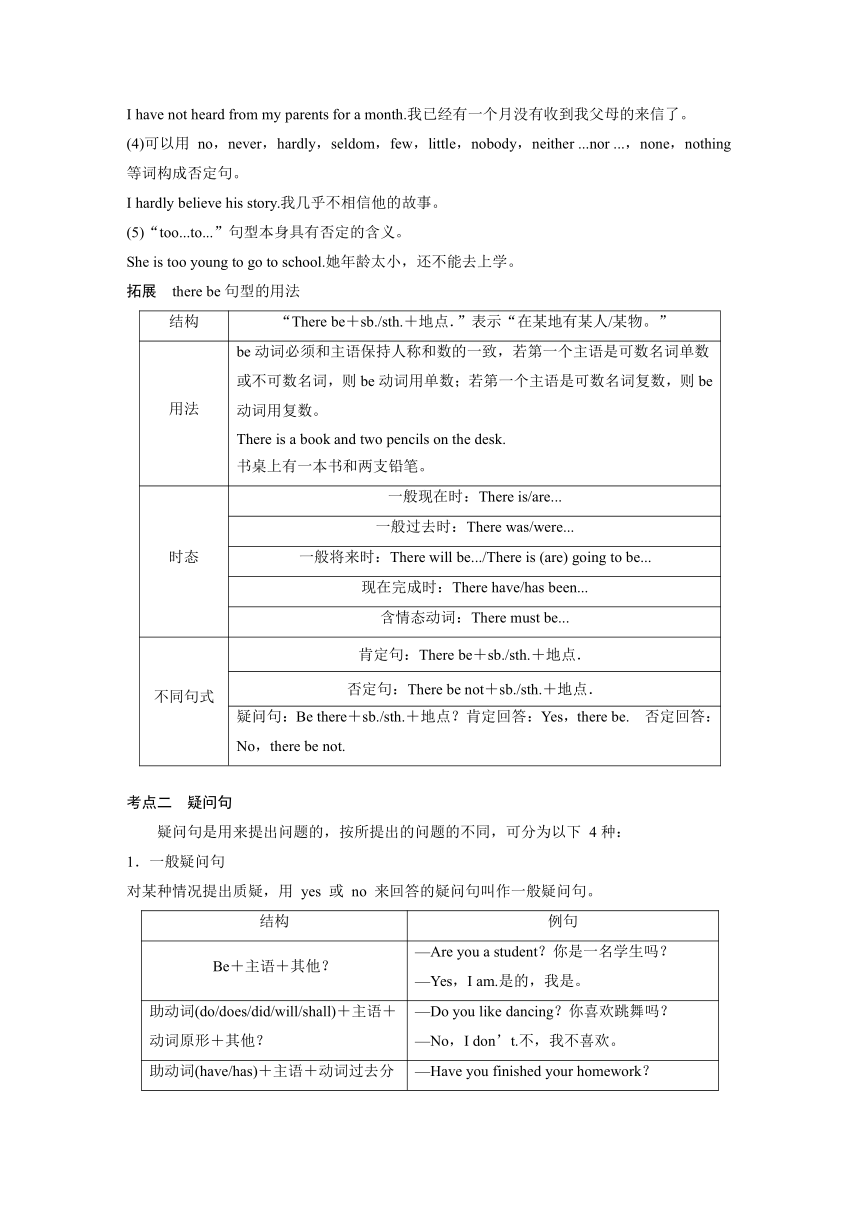
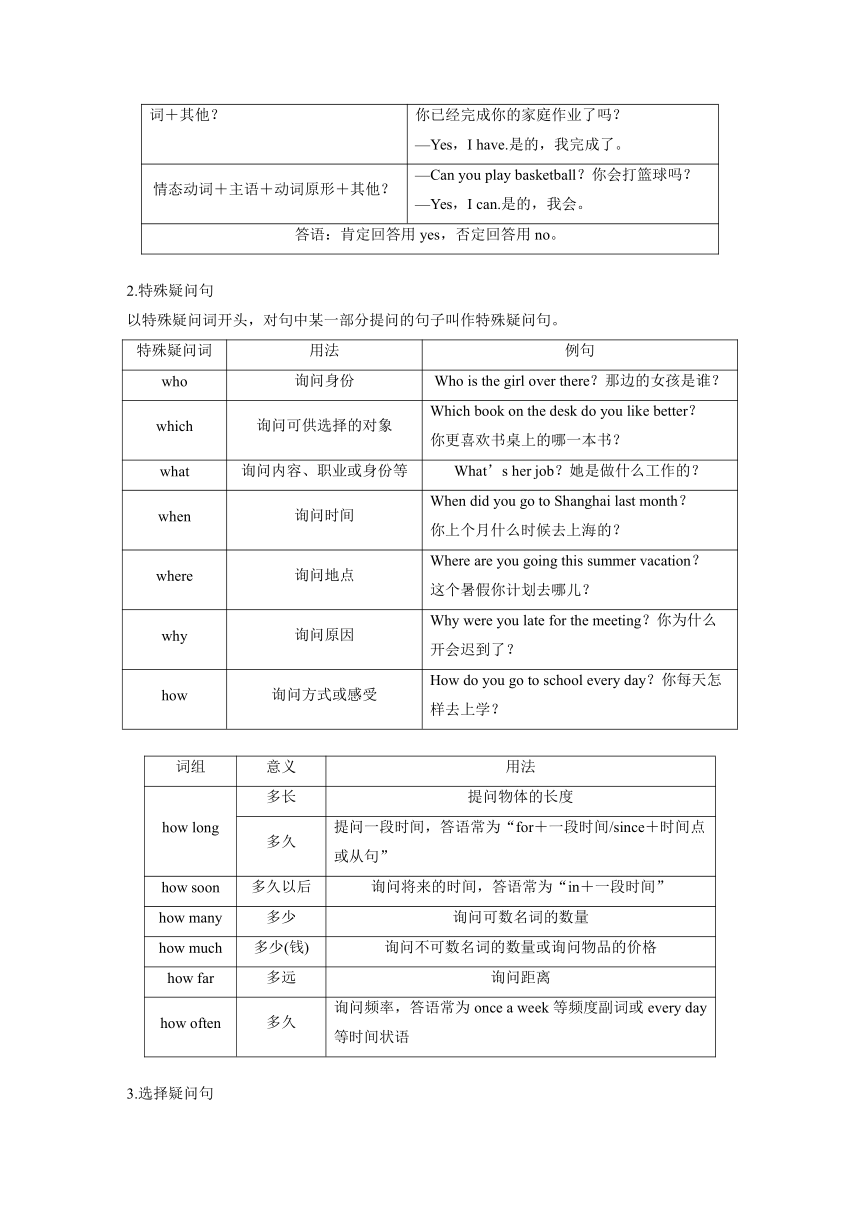
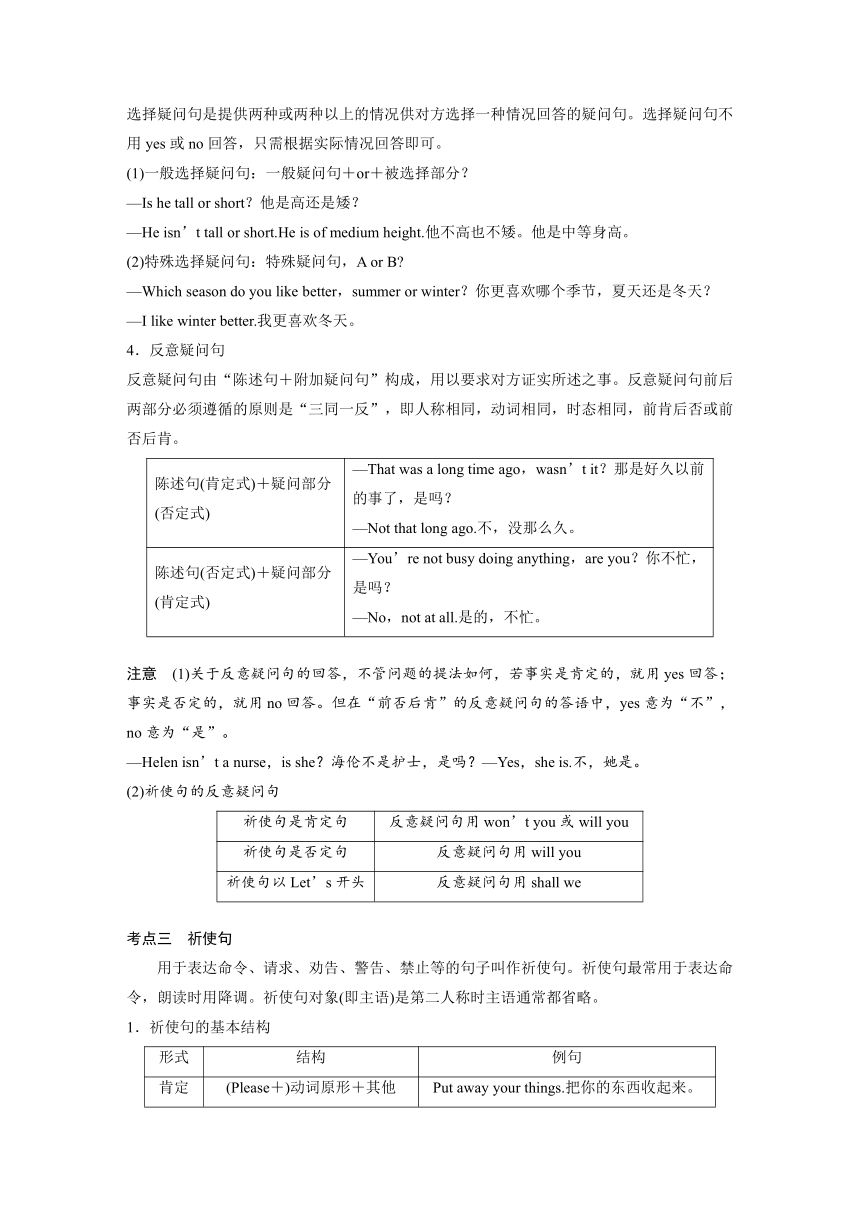
文档简介
专题五 简单句和复合句
第1讲 简单句
根据广东近五年的考情分析,简单句的题目设置在语法选择及短文填空中。对简单句的考查以感叹句为主,侧重引导词的区分;命题时会结合题型特点,考点设置不重复。
年份 语法选择 完形填空 短文填空
2023 35-感叹句引导词区分How — —
2022 — — 67-感叹句引导词区分how
2021 — — —
2020 39-感叹句引导词区分how — —
2019 — — —
只有一个主语(或并列主语)和一个谓语(或并列谓语)的句子叫简单句。
考点一 陈述句
陈述句常用来叙述一件事情或表明说话人的看法、态度等。其语序为主语在前,谓语在后,句末用句点。陈述句包括肯定结构和否定结构两种。
1.陈述句的肯定形式主要有五种基本句型
基本句型 说明 例句
主+谓(+状语)(SV) 谓语动词通常是不及物动词。 She always smiles. Mike works in a library.
主+(系)+表(SP) 谓语动词通常是连系动词,这个结构更确切地说叫“主+动+补”,表语实际是主语补足语。 He is a doctor. Ming feels sad.
主+谓+宾(SVO) 谓语动词通常是及物动词,后带宾语。此结构的谓语动词叫作“单宾语及物动词”。 We like cartoons. I had a cold last week.
主+谓+间宾+直宾(SVOO) 这种结构的谓语动词叫作“双宾语及物动词”。 My mother bought me a pen. The cinema will show us a new movie.
主+谓+宾+宾补(SVOC) 谓语动词之后必须跟宾语和宾语补足语,这种动词叫作“复杂宾语及物动词”。 You should keep your room tidy. Dad saw John playing volleyball.
注意 有些动词后面有两个宾语,间接宾语一般指人,直接宾语一般指物。一般是间接宾语在前,直接宾语在后。当直接宾语在前时,要加上介词for或to。
加to的动词有 bring(拿来);give(给);hand(递给);pass(递给);post(寄给);return(还给);sell(卖给);send(发送);show(给……看);offer(提供)等
加for的动词有 buy(买);draw(画);make(制作);choose(选择)等
2.陈述句的否定形式
(1)主语+be 动词+not+其他。
(2)主语+情态动词/助动词(do/does/did/will/shall)+not+动词原形+其他。
I didn’t get up at six o’clock this morning.今天早上六点我没有起床。
(3)主语+助动词(have/has)+not+动词过去分词+其他。
I have not heard from my parents for a month.我已经有一个月没有收到我父母的来信了。
(4)可以用 no,never,hardly,seldom,few,little,nobody,neither ...nor ...,none,nothing等词构成否定句。
I hardly believe his story.我几乎不相信他的故事。
(5)“too...to...”句型本身具有否定的含义。
She is too young to go to school.她年龄太小,还不能去上学。
拓展 there be句型的用法
结构 “There be+sb./sth.+地点.”表示“在某地有某人/某物。”
用法 be动词必须和主语保持人称和数的一致,若第一个主语是可数名词单数或不可数名词,则be动词用单数;若第一个主语是可数名词复数,则be动词用复数。 There is a book and two pencils on the desk. 书桌上有一本书和两支铅笔。
时态 一般现在时:There is/are...
一般过去时:There was/were...
一般将来时:There will be.../There is (are) going to be...
现在完成时:There have/has been...
含情态动词:There must be...
不同句式 肯定句:There be+sb./sth.+地点.
否定句:There be not+sb./sth.+地点.
疑问句:Be there+sb./sth.+地点?肯定回答:Yes,there be. 否定回答:No,there be not.
考点二 疑问句
疑问句是用来提出问题的,按所提出的问题的不同,可分为以下 4种:
1.一般疑问句
对某种情况提出质疑,用 yes 或 no 来回答的疑问句叫作一般疑问句。
结构 例句
Be+主语+其他? —Are you a student?你是一名学生吗? —Yes,I am.是的,我是。
助动词(do/does/did/will/shall)+主语+动词原形+其他? —Do you like dancing?你喜欢跳舞吗? —No,I don’t.不,我不喜欢。
助动词(have/has)+主语+动词过去分词+其他? —Have you finished your homework? 你已经完成你的家庭作业了吗? —Yes,I have.是的,我完成了。
情态动词+主语+动词原形+其他? —Can you play basketball?你会打篮球吗? —Yes,I can.是的,我会。
答语:肯定回答用yes,否定回答用no。
2.特殊疑问句
以特殊疑问词开头,对句中某一部分提问的句子叫作特殊疑问句。
特殊疑问词 用法 例句
who 询问身份 Who is the girl over there?那边的女孩是谁?
which 询问可供选择的对象 Which book on the desk do you like better? 你更喜欢书桌上的哪一本书?
what 询问内容、职业或身份等 What’s her job?她是做什么工作的?
when 询问时间 When did you go to Shanghai last month? 你上个月什么时候去上海的?
where 询问地点 Where are you going this summer vacation? 这个暑假你计划去哪儿?
why 询问原因 Why were you late for the meeting?你为什么开会迟到了?
how 询问方式或感受 How do you go to school every day?你每天怎样去上学?
词组 意义 用法
how long 多长 提问物体的长度
多久 提问一段时间,答语常为“for+一段时间/since+时间点或从句”
how soon 多久以后 询问将来的时间,答语常为“in+一段时间”
how many 多少 询问可数名词的数量
how much 多少(钱) 询问不可数名词的数量或询问物品的价格
how far 多远 询问距离
how often 多久 询问频率,答语常为once a week等频度副词或every day等时间状语
3.选择疑问句
选择疑问句是提供两种或两种以上的情况供对方选择一种情况回答的疑问句。选择疑问句不用yes或no回答,只需根据实际情况回答即可。
(1)一般选择疑问句:一般疑问句+or+被选择部分?
—Is he tall or short?他是高还是矮?
—He isn’t tall or short.He is of medium height.他不高也不矮。他是中等身高。
(2)特殊选择疑问句:特殊疑问句,A or B
—Which season do you like better,summer or winter?你更喜欢哪个季节,夏天还是冬天?
—I like winter better.我更喜欢冬天。
4.反意疑问句
反意疑问句由“陈述句+附加疑问句”构成,用以要求对方证实所述之事。反意疑问句前后两部分必须遵循的原则是“三同一反”,即人称相同,动词相同,时态相同,前肯后否或前否后肯。
陈述句(肯定式)+疑问部分(否定式) —That was a long time ago,wasn’t it?那是好久以前的事了,是吗? —Not that long ago.不,没那么久。
陈述句(否定式)+疑问部分(肯定式) —You’re not busy doing anything,are you?你不忙,是吗? —No,not at all.是的,不忙。
注意 (1)关于反意疑问句的回答,不管问题的提法如何,若事实是肯定的,就用yes回答;事实是否定的,就用no回答。但在“前否后肯”的反意疑问句的答语中,yes意为“不”,no意为“是”。
—Helen isn’t a nurse,is she?海伦不是护士,是吗?—Yes,she is.不,她是。
(2)祈使句的反意疑问句
祈使句是肯定句 反意疑问句用won’t you或will you
祈使句是否定句 反意疑问句用will you
祈使句以Let’s开头 反意疑问句用shall we
考点三 祈使句
用于表达命令、请求、劝告、警告、禁止等的句子叫作祈使句。祈使句最常用于表达命令,朗读时用降调。祈使句对象(即主语)是第二人称时主语通常都省略。
1.祈使句的基本结构
形式 结构 例句
肯定 形式 (Please+)动词原形+其他 Put away your things.把你的东西收起来。
Be+表语+其他 Be quiet,please.请安静。
Let+宾语+动词原形+其他 Let’s have another try.让我们再试试。
否定 形式 Don’t+动词原形+其他 Don’t open the window.不要打开窗户。
No+名词/动名词 No photos!禁止拍照! No parking!禁止停车!
Don’t let+宾语+动词原形+其他 =Let+宾语+not+动词原形+其他 Don’t let him go there alone.=Let him not go there alone.不要让他独自去那儿。
Never+动词原形 Never give up!永不放弃!
2.祈使句的用法
(1)回答祈使句时要用一般将来时。
—Don’t bring your mobile phone to school.不要把手机带到学校来。
—Sorry,I won’t.对不起,我不会了。
(2)祈使句+and/or+陈述句(表结果),可以置换成if条件句。
①Work hard,and you’ll get good grades.努力学习,你将会取得好成绩。
②Hurry up,or you’ll be late for class.=If you don’t hurry up,you’ll be late for class.如果你不快点,你上课就会迟到。
考点四 感叹句
感叹句是表示喜怒哀乐等情感的句子,一般用How或What引导。
1.感叹句的基本结构
形式 结构 例句
What引导 What+a/an+形容词+可数名词单数(+主语+谓语)! What a beautiful present(it is)! 多么漂亮的一件礼物啊!
What+形容词+不可数名词/可数名词复数(+主语+谓语)! What interesting books(they are)!多么有趣的书啊! What fine weather it is!多好的天气啊!
How引导 How+形容词/副词+主语+谓语! How fantastic the dragon boat teams were! 龙舟队多棒啊!
How+形容词+a/an/the+可数名词单数+谓语! How beautiful the present is! 多么漂亮的一件礼物啊!
How+主语+谓语! How time flies!时间过得真快呀!
2.How与What的选择方法
考点五 主谓一致
“一致”是指句子成分之间或词语之间在语法形式上的协调关系。主谓一致指主语和谓语动词之间在“人称”和“数”的方面的一致关系,这种一致关系常由三种不同的原则所支配,即语法一致原则、意义一致原则和就近原则。
1.语法一致
主语和谓语通常是在语法形式上取得一致,即主语是单数形式时,谓语动词也采用单数形式;主语是复数形式时,谓语动词也采用复数形式。
主语 谓语 例句
不可数名词、单数可数名词、第三人称单数 单数 The young man is from Nanjing. 那位年轻人来自南京。
复数名词、人称代词复数及第二人称you 复数 The children were in the classroom two hours ago. 孩子们两小时前在教室里。
both...and...连接的名词、代词 复数 Both Tom and Sam play the drums well. 汤姆和萨姆鼓打得都很好。
动词不定式、动词的-ing形式或从句 单数 Running every morning is good for us. 每天早晨跑步对我们有益。 What he said is not true.他说的不是真的。
one of+可数名词复数/复数代词 单数 One of the books is boring. 这些书里有一本很无聊。
either,neither,each,every或no+单数名词 单数 Each student has an English dictionary. 每个学生都有一本英语词典。
由every-,some-,any-,no-构成的复合不定代词 单数 Nothing is difficult if you put your heart into it. 世上无难事,只怕有心人。
主语后面跟有with,together with,except,but,like,as well as,including等时 取决于主语的数 The teacher with his students is going to visit the museum. 那个老师和他的学生们将去参观博物馆。
分数/百分数+of+名词 取决于短语后面的名词的数 Three fifths of the workers in the factory are men. 工厂里五分之三的工人是男性。
a lot of/lots of/plenty of/the rest of+名词 Lots of people have been to the Great Wall. 很多人去过长城。
定语从句中,关系代词that,who,which作主语时 与先行词的数保持一致 I like the students who study hard. 我喜欢努力学习的学生。
a number of+可数名词复数 复数 A number of books are given away to the poor students.许多书被捐赠给了那些贫穷的学生。
the number of+可数名词复数 单数 The number of the students in our class is 50. 我们班学生的数量是50。
a pair+of+可数名词复数 单数 A pair of new shoes is given to him as a present by his grandma.他奶奶送给他一双新鞋作为礼物。
数词+pairs/kinds+of+可数名词复数 复数 Sixty pairs of socks are sold every week on average in the shop.这家商店平均每周卖60双袜子。
2.意义一致
主语 谓语 例句
集体名词(如family/class/team/group/public等) 取决于主语的意义 My host family is really nice.(作为整体时,用单数) 我的寄宿家庭特别好。 It’s 9:00 a.m.and Zhu Hui’s family are at home.(指成员时,用复数)现在是早上9点,朱慧全家人都在家。
集合名词(如people/police/cattle等) 复数 The police are helping a girl to look for her mother. 警察正在帮一个女孩找她的妈妈。
the+姓氏名词复数,表示“……一家”或“……夫妇” The Blacks enjoy working in China. 布莱克一家喜欢在中国工作。
the+某些形容词,表示一类人 The young are energetic.年轻人都精力充沛。
由and连接两个名词 两个名词指不同的人或物 复数 The writer and the actor have come to the party together.这位作家和这位演员已经一起来到了这场晚会。
两个名词指同一人或物 单数 The writer and actor has come to the party. 这位作家兼演员已经来到了这场晚会。
表示时间、价格、重量、数目、长度及数学运算等的词或短语作主语时,作为一个整体,谓语动词用单数形式 Two months is a long holiday.两个月是一段长假。 Ten miles isn’t a long distance. 十英里并不是一段很长的距离。
3.就近原则
主语 谓语 例句
由or,either...or...,neither...nor...,not only...but also...,not...but...连接两个名词或代词 谓语动词与较近的主语在人称和数上保持一致 Either you or Jack is wrong. 不是你错了就是杰克错了。 Not only the students but also the teacher likes to see the movie. 不仅学生们喜欢看这部电影,老师也喜欢看。
there be...和here be... be动词与最近的主语在人称和数上保持一致 There is a table and two chairs in Sally’s room. 在萨莉的房间里有一张桌子和两把椅子。
一、单项填空
1.(2023·四川达州)—Neither Lily nor her parents outdoors when the rainstorm came.
— lucky they were!
A.were;What B.was;How C.were;How
答案 C
2.I plan to travel to America next month,and I think 2,000 dollars enough.
A.was B.are C.is D.were
答案 C
3.This pair of socks soft,I’ll take .
A.feel;it B.feels;it C.feels;them D.feel;them
答案 C
4.Either the students or the teacher him very well.
A.knows B.to know C.know D.knowing
答案 A
5.—Tom, here to carry the luggage upstairs for me,will you
—All right.
A.come B.came C.coming D.to come
答案 A
二、语法选择
Tom was a college student.He often made excuses not to attend classes.Also,he spent much of his free time 1 computer games.He never went to the library 2 .
3 time flew!At the end of the term,there was one important event that he was afraid of—the final exam.“ 4 should I do?” Tom walked up and down in the room the day before the exam.He was nervous.Suddenly he thought of 5 idea.
The next morning,Tom went into the exam room very early.He found a young man 6 looked so confident and took a seat next to him.“Hey you!”Tom greeted.“What?”The young man asked.
“ 7 you do me a favor?”Tom begged(恳求).“Please 8 me copy your paper during the exam.I have to depend on you!”When hearing his words,the young man just smiled but said nothing.
When the bell rang,the young man stood up immediately and came to the front,saying,“It is time for the final exam!Now I will hand out the papers to all of you and collect them 9 an hour.”
Tom sat there with 10 mouth wide open.
1.A.play B.plays C.playing
答案 C
2.A.to study B.to be studying C.studying
答案 A
3.A.How B.How a C.What
答案 A
4.A.Which B.When C.What
答案 C
5.A.a B.an C.the
答案 B
6.A.what B.which C.who
答案 C
7.A.May B.Can C.Must
答案 B
8.A.let B.letting C.to let
答案 A
9.A.in B.after C.before
答案 A
10.A.he B.his C.him
答案 B
第1讲 简单句
根据广东近五年的考情分析,简单句的题目设置在语法选择及短文填空中。对简单句的考查以感叹句为主,侧重引导词的区分;命题时会结合题型特点,考点设置不重复。
年份 语法选择 完形填空 短文填空
2023 35-感叹句引导词区分How — —
2022 — — 67-感叹句引导词区分how
2021 — — —
2020 39-感叹句引导词区分how — —
2019 — — —
只有一个主语(或并列主语)和一个谓语(或并列谓语)的句子叫简单句。
考点一 陈述句
陈述句常用来叙述一件事情或表明说话人的看法、态度等。其语序为主语在前,谓语在后,句末用句点。陈述句包括肯定结构和否定结构两种。
1.陈述句的肯定形式主要有五种基本句型
基本句型 说明 例句
主+谓(+状语)(SV) 谓语动词通常是不及物动词。 She always smiles. Mike works in a library.
主+(系)+表(SP) 谓语动词通常是连系动词,这个结构更确切地说叫“主+动+补”,表语实际是主语补足语。 He is a doctor. Ming feels sad.
主+谓+宾(SVO) 谓语动词通常是及物动词,后带宾语。此结构的谓语动词叫作“单宾语及物动词”。 We like cartoons. I had a cold last week.
主+谓+间宾+直宾(SVOO) 这种结构的谓语动词叫作“双宾语及物动词”。 My mother bought me a pen. The cinema will show us a new movie.
主+谓+宾+宾补(SVOC) 谓语动词之后必须跟宾语和宾语补足语,这种动词叫作“复杂宾语及物动词”。 You should keep your room tidy. Dad saw John playing volleyball.
注意 有些动词后面有两个宾语,间接宾语一般指人,直接宾语一般指物。一般是间接宾语在前,直接宾语在后。当直接宾语在前时,要加上介词for或to。
加to的动词有 bring(拿来);give(给);hand(递给);pass(递给);post(寄给);return(还给);sell(卖给);send(发送);show(给……看);offer(提供)等
加for的动词有 buy(买);draw(画);make(制作);choose(选择)等
2.陈述句的否定形式
(1)主语+be 动词+not+其他。
(2)主语+情态动词/助动词(do/does/did/will/shall)+not+动词原形+其他。
I didn’t get up at six o’clock this morning.今天早上六点我没有起床。
(3)主语+助动词(have/has)+not+动词过去分词+其他。
I have not heard from my parents for a month.我已经有一个月没有收到我父母的来信了。
(4)可以用 no,never,hardly,seldom,few,little,nobody,neither ...nor ...,none,nothing等词构成否定句。
I hardly believe his story.我几乎不相信他的故事。
(5)“too...to...”句型本身具有否定的含义。
She is too young to go to school.她年龄太小,还不能去上学。
拓展 there be句型的用法
结构 “There be+sb./sth.+地点.”表示“在某地有某人/某物。”
用法 be动词必须和主语保持人称和数的一致,若第一个主语是可数名词单数或不可数名词,则be动词用单数;若第一个主语是可数名词复数,则be动词用复数。 There is a book and two pencils on the desk. 书桌上有一本书和两支铅笔。
时态 一般现在时:There is/are...
一般过去时:There was/were...
一般将来时:There will be.../There is (are) going to be...
现在完成时:There have/has been...
含情态动词:There must be...
不同句式 肯定句:There be+sb./sth.+地点.
否定句:There be not+sb./sth.+地点.
疑问句:Be there+sb./sth.+地点?肯定回答:Yes,there be. 否定回答:No,there be not.
考点二 疑问句
疑问句是用来提出问题的,按所提出的问题的不同,可分为以下 4种:
1.一般疑问句
对某种情况提出质疑,用 yes 或 no 来回答的疑问句叫作一般疑问句。
结构 例句
Be+主语+其他? —Are you a student?你是一名学生吗? —Yes,I am.是的,我是。
助动词(do/does/did/will/shall)+主语+动词原形+其他? —Do you like dancing?你喜欢跳舞吗? —No,I don’t.不,我不喜欢。
助动词(have/has)+主语+动词过去分词+其他? —Have you finished your homework? 你已经完成你的家庭作业了吗? —Yes,I have.是的,我完成了。
情态动词+主语+动词原形+其他? —Can you play basketball?你会打篮球吗? —Yes,I can.是的,我会。
答语:肯定回答用yes,否定回答用no。
2.特殊疑问句
以特殊疑问词开头,对句中某一部分提问的句子叫作特殊疑问句。
特殊疑问词 用法 例句
who 询问身份 Who is the girl over there?那边的女孩是谁?
which 询问可供选择的对象 Which book on the desk do you like better? 你更喜欢书桌上的哪一本书?
what 询问内容、职业或身份等 What’s her job?她是做什么工作的?
when 询问时间 When did you go to Shanghai last month? 你上个月什么时候去上海的?
where 询问地点 Where are you going this summer vacation? 这个暑假你计划去哪儿?
why 询问原因 Why were you late for the meeting?你为什么开会迟到了?
how 询问方式或感受 How do you go to school every day?你每天怎样去上学?
词组 意义 用法
how long 多长 提问物体的长度
多久 提问一段时间,答语常为“for+一段时间/since+时间点或从句”
how soon 多久以后 询问将来的时间,答语常为“in+一段时间”
how many 多少 询问可数名词的数量
how much 多少(钱) 询问不可数名词的数量或询问物品的价格
how far 多远 询问距离
how often 多久 询问频率,答语常为once a week等频度副词或every day等时间状语
3.选择疑问句
选择疑问句是提供两种或两种以上的情况供对方选择一种情况回答的疑问句。选择疑问句不用yes或no回答,只需根据实际情况回答即可。
(1)一般选择疑问句:一般疑问句+or+被选择部分?
—Is he tall or short?他是高还是矮?
—He isn’t tall or short.He is of medium height.他不高也不矮。他是中等身高。
(2)特殊选择疑问句:特殊疑问句,A or B
—Which season do you like better,summer or winter?你更喜欢哪个季节,夏天还是冬天?
—I like winter better.我更喜欢冬天。
4.反意疑问句
反意疑问句由“陈述句+附加疑问句”构成,用以要求对方证实所述之事。反意疑问句前后两部分必须遵循的原则是“三同一反”,即人称相同,动词相同,时态相同,前肯后否或前否后肯。
陈述句(肯定式)+疑问部分(否定式) —That was a long time ago,wasn’t it?那是好久以前的事了,是吗? —Not that long ago.不,没那么久。
陈述句(否定式)+疑问部分(肯定式) —You’re not busy doing anything,are you?你不忙,是吗? —No,not at all.是的,不忙。
注意 (1)关于反意疑问句的回答,不管问题的提法如何,若事实是肯定的,就用yes回答;事实是否定的,就用no回答。但在“前否后肯”的反意疑问句的答语中,yes意为“不”,no意为“是”。
—Helen isn’t a nurse,is she?海伦不是护士,是吗?—Yes,she is.不,她是。
(2)祈使句的反意疑问句
祈使句是肯定句 反意疑问句用won’t you或will you
祈使句是否定句 反意疑问句用will you
祈使句以Let’s开头 反意疑问句用shall we
考点三 祈使句
用于表达命令、请求、劝告、警告、禁止等的句子叫作祈使句。祈使句最常用于表达命令,朗读时用降调。祈使句对象(即主语)是第二人称时主语通常都省略。
1.祈使句的基本结构
形式 结构 例句
肯定 形式 (Please+)动词原形+其他 Put away your things.把你的东西收起来。
Be+表语+其他 Be quiet,please.请安静。
Let+宾语+动词原形+其他 Let’s have another try.让我们再试试。
否定 形式 Don’t+动词原形+其他 Don’t open the window.不要打开窗户。
No+名词/动名词 No photos!禁止拍照! No parking!禁止停车!
Don’t let+宾语+动词原形+其他 =Let+宾语+not+动词原形+其他 Don’t let him go there alone.=Let him not go there alone.不要让他独自去那儿。
Never+动词原形 Never give up!永不放弃!
2.祈使句的用法
(1)回答祈使句时要用一般将来时。
—Don’t bring your mobile phone to school.不要把手机带到学校来。
—Sorry,I won’t.对不起,我不会了。
(2)祈使句+and/or+陈述句(表结果),可以置换成if条件句。
①Work hard,and you’ll get good grades.努力学习,你将会取得好成绩。
②Hurry up,or you’ll be late for class.=If you don’t hurry up,you’ll be late for class.如果你不快点,你上课就会迟到。
考点四 感叹句
感叹句是表示喜怒哀乐等情感的句子,一般用How或What引导。
1.感叹句的基本结构
形式 结构 例句
What引导 What+a/an+形容词+可数名词单数(+主语+谓语)! What a beautiful present(it is)! 多么漂亮的一件礼物啊!
What+形容词+不可数名词/可数名词复数(+主语+谓语)! What interesting books(they are)!多么有趣的书啊! What fine weather it is!多好的天气啊!
How引导 How+形容词/副词+主语+谓语! How fantastic the dragon boat teams were! 龙舟队多棒啊!
How+形容词+a/an/the+可数名词单数+谓语! How beautiful the present is! 多么漂亮的一件礼物啊!
How+主语+谓语! How time flies!时间过得真快呀!
2.How与What的选择方法
考点五 主谓一致
“一致”是指句子成分之间或词语之间在语法形式上的协调关系。主谓一致指主语和谓语动词之间在“人称”和“数”的方面的一致关系,这种一致关系常由三种不同的原则所支配,即语法一致原则、意义一致原则和就近原则。
1.语法一致
主语和谓语通常是在语法形式上取得一致,即主语是单数形式时,谓语动词也采用单数形式;主语是复数形式时,谓语动词也采用复数形式。
主语 谓语 例句
不可数名词、单数可数名词、第三人称单数 单数 The young man is from Nanjing. 那位年轻人来自南京。
复数名词、人称代词复数及第二人称you 复数 The children were in the classroom two hours ago. 孩子们两小时前在教室里。
both...and...连接的名词、代词 复数 Both Tom and Sam play the drums well. 汤姆和萨姆鼓打得都很好。
动词不定式、动词的-ing形式或从句 单数 Running every morning is good for us. 每天早晨跑步对我们有益。 What he said is not true.他说的不是真的。
one of+可数名词复数/复数代词 单数 One of the books is boring. 这些书里有一本很无聊。
either,neither,each,every或no+单数名词 单数 Each student has an English dictionary. 每个学生都有一本英语词典。
由every-,some-,any-,no-构成的复合不定代词 单数 Nothing is difficult if you put your heart into it. 世上无难事,只怕有心人。
主语后面跟有with,together with,except,but,like,as well as,including等时 取决于主语的数 The teacher with his students is going to visit the museum. 那个老师和他的学生们将去参观博物馆。
分数/百分数+of+名词 取决于短语后面的名词的数 Three fifths of the workers in the factory are men. 工厂里五分之三的工人是男性。
a lot of/lots of/plenty of/the rest of+名词 Lots of people have been to the Great Wall. 很多人去过长城。
定语从句中,关系代词that,who,which作主语时 与先行词的数保持一致 I like the students who study hard. 我喜欢努力学习的学生。
a number of+可数名词复数 复数 A number of books are given away to the poor students.许多书被捐赠给了那些贫穷的学生。
the number of+可数名词复数 单数 The number of the students in our class is 50. 我们班学生的数量是50。
a pair+of+可数名词复数 单数 A pair of new shoes is given to him as a present by his grandma.他奶奶送给他一双新鞋作为礼物。
数词+pairs/kinds+of+可数名词复数 复数 Sixty pairs of socks are sold every week on average in the shop.这家商店平均每周卖60双袜子。
2.意义一致
主语 谓语 例句
集体名词(如family/class/team/group/public等) 取决于主语的意义 My host family is really nice.(作为整体时,用单数) 我的寄宿家庭特别好。 It’s 9:00 a.m.and Zhu Hui’s family are at home.(指成员时,用复数)现在是早上9点,朱慧全家人都在家。
集合名词(如people/police/cattle等) 复数 The police are helping a girl to look for her mother. 警察正在帮一个女孩找她的妈妈。
the+姓氏名词复数,表示“……一家”或“……夫妇” The Blacks enjoy working in China. 布莱克一家喜欢在中国工作。
the+某些形容词,表示一类人 The young are energetic.年轻人都精力充沛。
由and连接两个名词 两个名词指不同的人或物 复数 The writer and the actor have come to the party together.这位作家和这位演员已经一起来到了这场晚会。
两个名词指同一人或物 单数 The writer and actor has come to the party. 这位作家兼演员已经来到了这场晚会。
表示时间、价格、重量、数目、长度及数学运算等的词或短语作主语时,作为一个整体,谓语动词用单数形式 Two months is a long holiday.两个月是一段长假。 Ten miles isn’t a long distance. 十英里并不是一段很长的距离。
3.就近原则
主语 谓语 例句
由or,either...or...,neither...nor...,not only...but also...,not...but...连接两个名词或代词 谓语动词与较近的主语在人称和数上保持一致 Either you or Jack is wrong. 不是你错了就是杰克错了。 Not only the students but also the teacher likes to see the movie. 不仅学生们喜欢看这部电影,老师也喜欢看。
there be...和here be... be动词与最近的主语在人称和数上保持一致 There is a table and two chairs in Sally’s room. 在萨莉的房间里有一张桌子和两把椅子。
一、单项填空
1.(2023·四川达州)—Neither Lily nor her parents outdoors when the rainstorm came.
— lucky they were!
A.were;What B.was;How C.were;How
答案 C
2.I plan to travel to America next month,and I think 2,000 dollars enough.
A.was B.are C.is D.were
答案 C
3.This pair of socks soft,I’ll take .
A.feel;it B.feels;it C.feels;them D.feel;them
答案 C
4.Either the students or the teacher him very well.
A.knows B.to know C.know D.knowing
答案 A
5.—Tom, here to carry the luggage upstairs for me,will you
—All right.
A.come B.came C.coming D.to come
答案 A
二、语法选择
Tom was a college student.He often made excuses not to attend classes.Also,he spent much of his free time 1 computer games.He never went to the library 2 .
3 time flew!At the end of the term,there was one important event that he was afraid of—the final exam.“ 4 should I do?” Tom walked up and down in the room the day before the exam.He was nervous.Suddenly he thought of 5 idea.
The next morning,Tom went into the exam room very early.He found a young man 6 looked so confident and took a seat next to him.“Hey you!”Tom greeted.“What?”The young man asked.
“ 7 you do me a favor?”Tom begged(恳求).“Please 8 me copy your paper during the exam.I have to depend on you!”When hearing his words,the young man just smiled but said nothing.
When the bell rang,the young man stood up immediately and came to the front,saying,“It is time for the final exam!Now I will hand out the papers to all of you and collect them 9 an hour.”
Tom sat there with 10 mouth wide open.
1.A.play B.plays C.playing
答案 C
2.A.to study B.to be studying C.studying
答案 A
3.A.How B.How a C.What
答案 A
4.A.Which B.When C.What
答案 C
5.A.a B.an C.the
答案 B
6.A.what B.which C.who
答案 C
7.A.May B.Can C.Must
答案 B
8.A.let B.letting C.to let
答案 A
9.A.in B.after C.before
答案 A
10.A.he B.his C.him
答案 B
